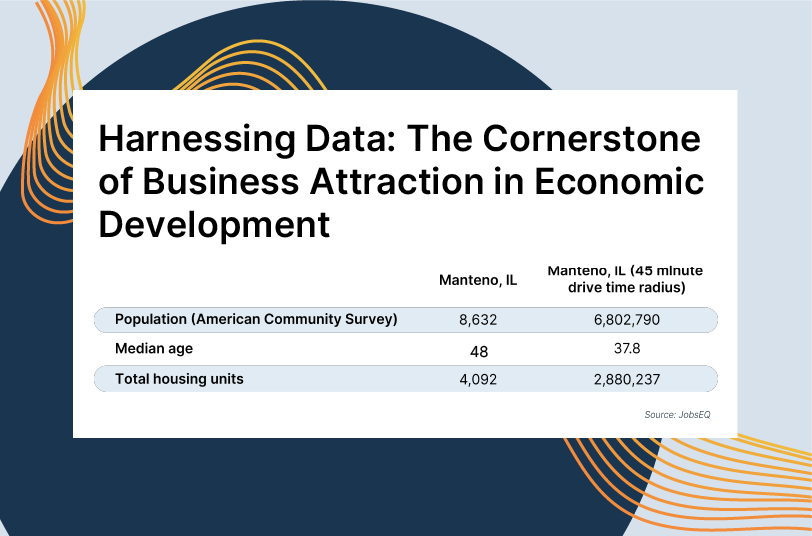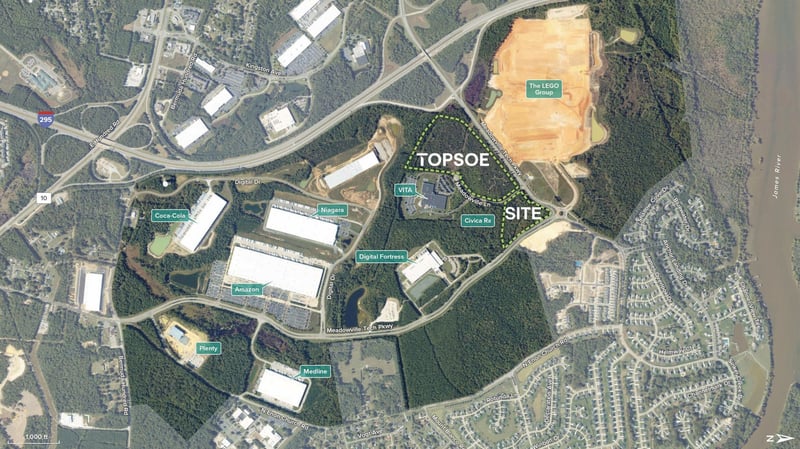Harnessing Data: The Cornerstone of Business Attraction in Economic Development

From small startups to multinational corporations, understanding the importance of data in business attraction is imperative for fostering economic growth and development. Two recent project announcements demonstrate how effective use of data lays the groundwork for successful projects long before any ground is broken.
In September 2023, Gotion announced a $2 billion investment in a new electric vehicle battery factory in Kankakee, Illinois.[1] The project will add 1,651 new jobs in phase one and 1,000 new jobs in phase two. Production is anticipated to commence for the lithium-ion battery packs and cells by late 2024.
When the announcement was made by Governor JB Pritzker, the project was proclaimed to be “the most significant new manufacturing investment in Illinois in decades” and the 5th largest economic incentive deal in the United States for 2023. The project is one that many communities seek to replicate, in hopes of such a large-scale job creation opportunity.
In April of this year, Topsoe announced a $400 million investment for the largest manufacturer of solid oxide electrolyzer cells in the world to produce clean hydrogen in Chesterfield County, Virginia.[1] The company, a Danish manufacturer, plans to create 150 new jobs and create a scholarship program for Chesterfield students in STEM education.
While these two projects differ in location, size, and project drivers, there are many similarities. Both Gotion and Toposoe are clean energy projects, a sector expected to continue significant growth (and the subject of a recent webinar Chmura hosted). The other main component that this and many other major projects have in common is pre-planning efforts by the community to understand their market and accurately use data to recruit high-tech manufacturing.
Labor data in business attraction
Data are the bedrock upon which successful economic strategies are built. Data provide invaluable insights into market trends, consumer behavior, competitive landscapes, and emerging opportunities. For regions aiming to attract businesses and spur economic development, harnessing the power of data is not just an option; it's a necessity.
One of the primary ways data fuel business attraction is through market intelligence. By analyzing demographic data, consumer preferences, and industry trends, regions can identify sectors with growth potential and tailor their strategies accordingly. Whether it's targeting emerging tech industries or niche markets, data empowers economic development agencies to align their efforts with market demand and local strengths.
In the case of Gotion, the Illinois community used data to show the 45-minute driving time labor shed to highlight the potential pull of the workforce.[3] The Village of Manteno, where the project is located, would have a difficult time supporting such a large project without drawing workers from Chicago and its suburbs. The drive-time region shown in the map above is associated with an available workforce that is almost 800 times larger than in the village alone, as well as more than 10 years younger on average. This suggests a strong supply of labor to fill open positions for years to come.

Infrastructure planning data
Data are instrumental in guiding infrastructure development, a crucial factor in business attraction. By analyzing transportation networks, utility availability, and real estate trends, regions can identify areas for improvement and investment. Whether it's expanding broadband access or developing industrial parks, data-driven infrastructure planning ensures that businesses have the resources they need to thrive.
With regard to the site where Topsoe is locating in Chesterfield, there’s no coincidence a clean energy company dedicated to high-quality production has selected Meadowville Technology Park as their landing spot in the United States. With recognizable brand names like Civica Rx, Coca-Cola, Amazon, Niagara Bottling, and the LEGO Group as neighbors, the industrial park is a list of who’s who in manufacturing. Recently, Plenty broke ground in Meadowville in April 2023 for production by early 2024 of the world’s largest vertical farm campus.

Source: Chesterfield County Economic Development
The journey from preparation to project success did not occur overnight. In the 1990’s, Meadowville began rezoning for an industrial park in the initial hopes of attracting the semiconductor industry.[4] Over time the industry targets have changed, but Chesterfield’s commitment for the park to have high-tech manufacturing growth for the county remained. To attract the caliber of companies that currently call Meadowville home, Chesterfield needed basic infrastructure for site development like roadways to handle truck traffic, electric capacity large enough to manage a campus of production facilities, ample water and wastewater for manufacturing needs, and enough broadband to accommodate technological growth for park tenants.
Targeted marketing data
Data also enhance the capabilities of economic development organizations to build targeted messages that resonate with growing industries. Through predictive analytics and customer segmentation, regions can identify companies that align with their strengths and offerings. Understanding the competitive landscape is essential for attracting businesses. Data allow regions to conduct comprehensive competitor analyses, identifying strengths, weaknesses, and areas of differentiation. With the right data sets, small and large economic development organizations can centralize their efforts and focus on targeted locations or industries that maximize their impact for business attraction.
Conclusion
Data are the benchmark of success in site selection and economic development. By leveraging data-driven insights, regions can better attract businesses, stimulate job growth, and drive innovation. From market intelligence to targeted marketing, data empower economic development agencies to make informed decisions and create environments where businesses can thrive.
[1] “Gov. Pritzker Announces Major Electric Vehicle Battery Factory Coming to Kankakee County”, Office of Governor J.B. Pritzker, September 8, 2023, https://gov.illinois.gov/news/press-release.26997.html
[2] Christina Martinez, “Global Clean Energy Manufacturer Topsoe to Invest $400 Million in Virginia”, Office of the Governor of Virginia, May 1, 2024, https://www.governor.virginia.gov/newsroom/news-releases/2024/may/name-1026403-en.html
[3] Lindsay Lopp, “How Kankakee County Secured the Largest EV Battery Investment in Illinois to Date”, Site Selection Magazine, March 2024, https://siteselection.com/issues/2024/mar/how-kankakee-county-secured-the-largest-ev-battery-investment-in-illinois-to-date.cfm
[4] Vanessa Remmers, “Before the megasite, there was Meadowville. Has the Chesterfield technology park paid off?”, Richmond Times-Dispatch, June 1, 2018, https://richmond.com/news/local/before-the-megasite-there-was-meadowville-has-the-chesterfield-technology-park-paid-off/article_7568d563-5025-5c78-9a7e-e3e14d7d11ce.html
Subscribe to the Weekly Economic Update
Subscribe to the Weekly Economic Update and get news delivered straight to your inbox.











